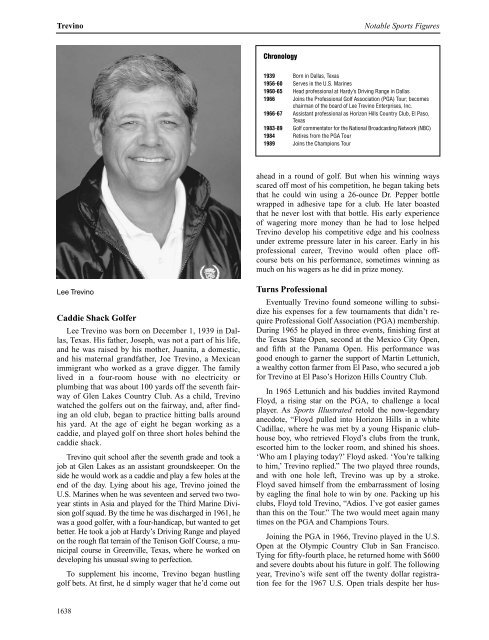Frank Thomas
Frank Thomas
Frank Thomas
You also want an ePaper? Increase the reach of your titles
YUMPU automatically turns print PDFs into web optimized ePapers that Google loves.
Trevino Notable Sports Figures<br />
Lee Trevino<br />
Caddie Shack Golfer<br />
Lee Trevino was born on December 1, 1939 in Dallas,<br />
Texas. His father, Joseph, was not a part of his life,<br />
and he was raised by his mother, Juanita, a domestic,<br />
and his maternal grandfather, Joe Trevino, a Mexican<br />
immigrant who worked as a grave digger. The family<br />
lived in a four-room house with no electricity or<br />
plumbing that was about 100 yards off the seventh fairway<br />
of Glen Lakes Country Club. As a child, Trevino<br />
watched the golfers out on the fairway, and, after finding<br />
an old club, began to practice hitting balls around<br />
his yard. At the age of eight he began working as a<br />
caddie, and played golf on three short holes behind the<br />
caddie shack.<br />
Trevino quit school after the seventh grade and took a<br />
job at Glen Lakes as an assistant groundskeeper. On the<br />
side he would work as a caddie and play a few holes at the<br />
end of the day. Lying about his age, Trevino joined the<br />
U.S. Marines when he was seventeen and served two twoyear<br />
stints in Asia and played for the Third Marine Division<br />
golf squad. By the time he was discharged in 1961, he<br />
was a good golfer, with a four-handicap, but wanted to get<br />
better. He took a job at Hardy’s Driving Range and played<br />
on the rough flat terrain of the Tenison Golf Course, a municipal<br />
course in Greenville, Texas, where he worked on<br />
developing his unusual swing to perfection.<br />
To supplement his income, Trevino began hustling<br />
golf bets. At first, he d simply wager that he’d come out<br />
1638<br />
Chronology<br />
1939 Born in Dallas, Texas<br />
1956-60 Serves in the U.S. Marines<br />
1960-65 Head professional at Hardy’s Driving Range in Dallas<br />
1966 Joins the Professional Golf Association (PGA) Tour; becomes<br />
chairman of the board of Lee Trevino Enterprises, Inc.<br />
1966-67 Assistant professional as Horizon Hills Country Club, El Paso,<br />
Texas<br />
1983-89 Golf commentator for the National Broadcasting Network (NBC)<br />
1984 Retires from the PGA Tour<br />
1989 Joins the Champions Tour<br />
ahead in a round of golf. But when his winning ways<br />
scared off most of his competition, he began taking bets<br />
that he could win using a 26-ounce Dr. Pepper bottle<br />
wrapped in adhesive tape for a club. He later boasted<br />
that he never lost with that bottle. His early experience<br />
of wagering more money than he had to lose helped<br />
Trevino develop his competitive edge and his coolness<br />
under extreme pressure later in his career. Early in his<br />
professional career, Trevino would often place offcourse<br />
bets on his performance, sometimes winning as<br />
much on his wagers as he did in prize money.<br />
Turns Professional<br />
Eventually Trevino found someone willing to subsidize<br />
his expenses for a few tournaments that didn’t require<br />
Professional Golf Association (PGA) membership.<br />
During 1965 he played in three events, finishing first at<br />
the Texas State Open, second at the Mexico City Open,<br />
and fifth at the Panama Open. His performance was<br />
good enough to garner the support of Martin Lettunich,<br />
a wealthy cotton farmer from El Paso, who secured a job<br />
for Trevino at El Paso’s Horizon Hills Country Club.<br />
In 1965 Lettunich and his buddies invited Raymond<br />
Floyd, a rising star on the PGA, to challenge a local<br />
player. As Sports Illustrated retold the now-legendary<br />
anecdote, “Floyd pulled into Horizon Hills in a white<br />
Cadillac, where he was met by a young Hispanic clubhouse<br />
boy, who retrieved Floyd’s clubs from the trunk,<br />
escorted him to the locker room, and shined his shoes.<br />
‘Who am I playing today?’ Floyd asked. ‘You’re talking<br />
to him,’ Trevino replied.” The two played three rounds,<br />
and with one hole left, Trevino was up by a stroke.<br />
Floyd saved himself from the embarrassment of losing<br />
by eagling the final hole to win by one. Packing up his<br />
clubs, Floyd told Trevino, “Adios. I’ve got easier games<br />
than this on the Tour.” The two would meet again many<br />
times on the PGA and Champions Tours.<br />
Joining the PGA in 1966, Trevino played in the U.S.<br />
Open at the Olympic Country Club in San Francisco.<br />
Tying for fifty-fourth place, he returned home with $600<br />
and severe doubts about his future in golf. The following<br />
year, Trevino’s wife sent off the twenty dollar registration<br />
fee for the 1967 U.S. Open trials despite her hus-

















